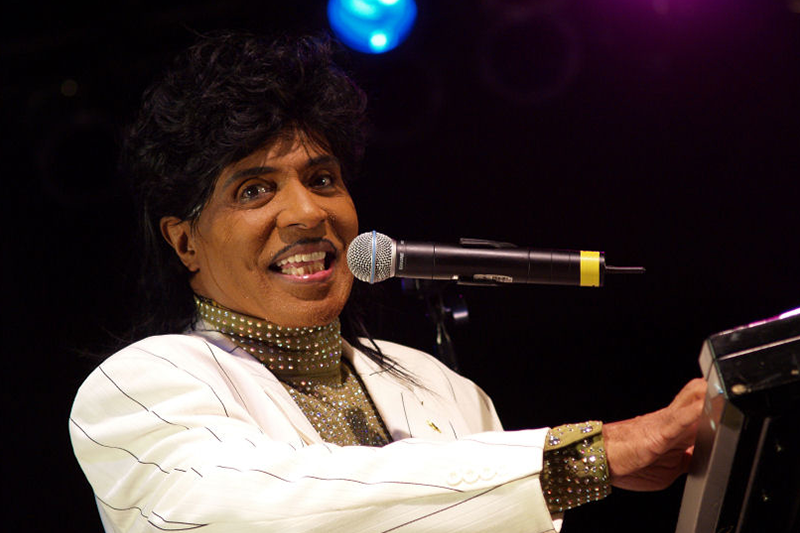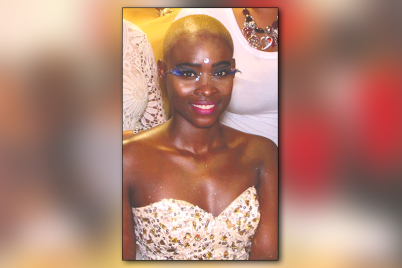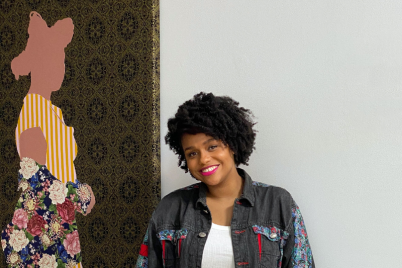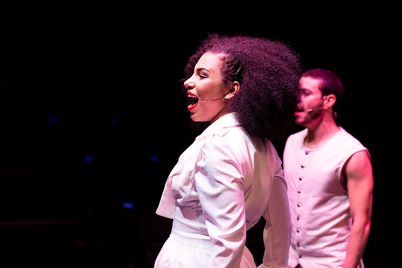BY FRANK DROUZAS, Staff Writer
More than midway through a 1963 television performance in England, Little Richard hit a point where he could contain himself no longer. He simply had to let loose.
Amidst a studio audience of young white kids, he opened the show with the lively “Rip It Up” dressed in a suit and tie. While holding a microphone in one hand and slapping a tambourine against his thigh with the other, he descended some stairs then moved around in a restless yet restrained manner.
Next, he sang the gospel number “Joy, Joy, Joy” with the Shirelles, where he mostly just snapped his fingers and marched in place before going to his piano to perform his rave-up “Lucille.” Yet even as he pounded the keys standing up and bounced lightly to the beat, it was clear he had yet to really pop.
It wasn’t until his rendition of “Whole Lotta Shakin’ Going On” that the boisterous genie burst out of the bottle. During his feverish delivery, he actually jumped up on top of the piano to jiggle up and down as he wailed mightily. Not missing a beat, he hopped off to remove his jacket and loosen his tie.
By now, his white shirt was soaked in sweat, but he was just getting warmed up. Any inhibitions, along with some of his clothes, had been stripped off as he continued to scream and stomp, drop down to his knees and rise to his feet like he was leading a church revival — and all to the enthusiastic handclaps of the young British generation.
In eruptive fits, he punctuated his frenzied pleas of “Won’t you shake it, baby?” with several vertical leaps into the air — an energetic pogo dance that would become a staple of punk rock shows in Britain over a full decade later.
Richard Penniman, the histrionic young man from Macon, Ga., who would become one of rock’s founding fathers, has often been nicknamed “The Originator.” I find it pointless to bestow broad titles like the “The Innovator” or “Architect of Rock and Roll” to a single performer, as rock and roll was, even in its nascent stage, bigger than any individual.
Sure, you can make arguments for your favorite candidates based on their unique contributions, but it was always a joint movement meant to be molded and remolded by various craftsmen over the years — you may as well go back to Big Mama Thornton, Sister Rosetta Tharpe or Robert Johnson if you want to go the who-did-what-first route.
But if you talk about the rise of rock in the 1950s and the vocal delivery of its pioneers, in my book Little Richard stands apart. Chuck Berry could smoothly run through his lyrics, Jerry Lee Lewis could fervidly rant-sing, and Elvis Presley could work his voice up into a lather, yet Little Richard at his best could attack a song like nobody’s business.
Bordering on banshee screeching, he belted out his words louder and faster than any of them and this vigorous vocal style — spewing the frenetic syllables like a man that’s come unhinged — showed that his proto-pogo dancing isn’t the only direct line you can draw from him to punk.
Recently while I was jogging and listening to my tunes on shuffle, “Long Tall Sally” suddenly came blasting through my earphones — an aural assault that felt like Little Richard’s voice had just kicked down a door to my head and was intent on trashing the place. The random will of the shuffle gods decreed that it would serve as the meat in a three-song sandwich of up-tempo tracks.
It had come on the heels of “London Calling” by the Clash, and it wasn’t hard for me to connect the dots from Joe Strummer’s desperate, wolf-like howls of distress to Little Richard’s primal shouts of “Woo–OOOH!” These formless ejaculations were as natural as exhaling to Little Richard — some of them falsetto, some of them sinister, all of them manic — and somehow they expressed sexual frustration and fulfillment at the same time.
“Liar” by the Sex Pistols came directly after “Long Tall Sally.” As I compared them side by side (as it were), I couldn’t help but smile at just how similar the recipe was — multiple words crammed into a single breath, frantic music trying to keep pace, all of it whipped together into a furious froth. Though “Liar” may also owe a debt to “Puss ‘N’ Boots” by the New York Dolls (another influential band), glam rockers like the Dolls must, in turn, acknowledge the debt they owe to Little Richard.
Directly preceding the blunt force of punk rock was the androgyny and sexual ambiguity of the glam rock scene, and Little Richard stands as one of its patron saints.
He showed interest in gender-bending at an early age, as he tried on his mother’s clothes and makeup as a youngster. By the time he was performing at venues like the Tick Tock Club early in his career, Little Richard had taken to wearing his hair in a high pompadour, thick eyeliner, face powder and outrageous, wildly-colorful outfits. His homosexuality may not have been publicly overt at this point, but his flamboyance and stage exuberance came shrieking through loud and clear.
Fast forward two decades, and you have the youth of the day taking not just a page out of Little Richard’s book but ripping out entire chapters. David Bowie adopted stage personas, donning shiny, garish gear, and an outlandish amount of makeup as his alter egos Ziggy Stardust and Aladdin Sane exuded an unmistakable appeal to both sexes.
The New York Dolls routinely performed while wearing women’s high heeled shoes, boas, glittery scarves and enough rouge to make Max Factor cringe. A true showman, Little Richard opened the door for the glamorous side of rock and roll to come out and strut its stuff, and his list of disciples includes Lou Reed, T. Rex, Kiss and Prince, to name a scant few.
The fashionable entrance of the glam rockers and the subsequent bursting in of the punk rockers in the mid-1970s were only the latest incarnations of rock and roll’s rebellious spirit, going back to the forefathers of rock. And though Little Richard’s peers faced an uphill climb with their musical revolt, it’s doubtful any of them had it tougher than he did.
You want to talk about rebellion or going against the grain in any way? Who could be more of an outsider than a gay, black kid from a family of preachers in the God-fearing Deep South that wanted to sing the devil’s music?
Yet his undeniable status as a social outsider served to heighten his appeal, namely to the youth. The very nature of his ambiguous sexuality and his outrageous performances lent him an anti-authoritative aura at a time when teens were coming into their own as a distinct sociological force to be reckoned with.
Little Richard struck a chord with the young as he represented not only everything their fathers and teachers weren’t but smashed the stifling, antediluvian notion that young people should submissively direct their footsteps to follow society’s expectations.
Throw his race into the volatile mix, and you can see why some of the older generations saw him as a threat. Yes, his affectations may have been campy, and yes, he may have worn eyeliner, but still, he had something that made white fathers of teenage girls regard him as a panther with a frilly bow tied around his tail.
His eyes were wild, and his facial muscles jumped around as he sang. His body jerked and swayed when he performed in a way that underscored his unabashed lust — some females at his concerts would rush the stage just to touch him, while others tossed their underwear at him. Make no mistake; what he was doing was thrilling, new and dangerous.
His religious roots took hold of him in the late 1950s, however, as he decided to abandon the wildness of rock and roll and turn to the pious comforts of gospel music. And while he knew his way around a gospel tune better than most people — the legendary Mahalia Jackson herself would claim he sang it the way it should be sung — Little Richard found he couldn’t turn his back on rock forever. It was too much a part of him.
By the time of the British TV special — taped in Nov. 1963 and aired in early 1964 — he was a grown man in his 30s and had only recently returned to the rock and roll fold. Yet after tearing through “Whole Lotta Shakin’ Going On,” he turned up the heat, delivering blistering versions of “Hound Dog,” “Good Golly Miss Molly,” “Tutti Frutti” and “Jenny Jenny.”
And as he was squealing and howling, whooping and yowling, jumping on a piano and raising hell, he showed that his fervent rebellious spirit had never gone lukewarm. It had merely been simmering, ready to boil over at any moment he chose.
During his performance, the kids in that studio — and their younger siblings who would ultimately watch it on TV –danced, clapped, shimmied and shook along with Little Richard. And took notes.
To reach Frank Drouzas, email fdrouzas@theweeklychallenger.com








